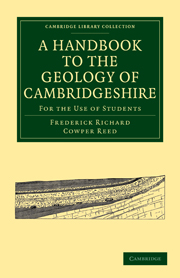THE ANTIQUITY OF MAN IN THE DISTRICT
Published online by Cambridge University Press: 05 July 2011
Summary
In this district there are but few traces of the presence of Palæolithic man, though in the adjoining counties river-drift implements have been found in considerable numbers. A few such implements have been recorded from the gravels of the Cam valley. Prof. Seeley discovered a rib bone of an elephant, marked with peculiar sharp cuts, in a marl bed at Barnwell associated with the characteristic shells of the Barnwell Terrace of river-gravel, but whether the cuts on this bone were made by man or in some other way is a disputed point. A flint hache, closely corresponding to some found at Biddenham in Bedfordshire in gravels of the age of the Barnwell Terrace, is stated to have been found in the gravel of the Barnwell pit and was described by Mr A. F. Griffith in 1878.
Other worked flints of Palæolithic types have been picked up on heaps of gravel near Cambridge, and one is stated to have been found in the Barrington gravels. Prof. Bonney mentions a flint flake from the gravel of Midsummer Common, and a rude implement believed to have come from the Observatory gravel. The pointed implement from the neighbourhood of Burwell, which was described by Prof. Babington, is of doubtful genuineness and probably is a forgery. An undoubted palæolithic implement has been found in the March gravels, and it has been suggested that the implement-bearing gravels of Brandon in Suffolk are allied to those of the ancient river-system in our county to which the March gravels are ascribed.
- Type
- Chapter
- Information
- A Handbook to the Geology of CambridgeshireFor the Use of Students, pp. 237 - 239Publisher: Cambridge University PressPrint publication year: 2009First published in: 1897



